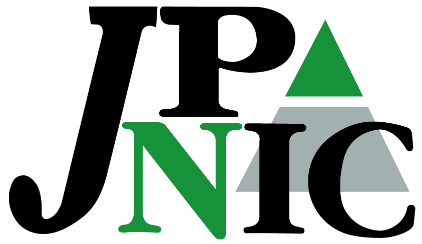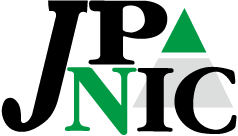open all section menu
close all section menu
- + Preface
- + Chapter1 Resource Management and Registry
- + Chapter2 Resource management before JNIC and JPNIC
- + Chapter3 Restructuring toward fully-fledged resource management by JPNIC
- + Chapter4 Transition of resource management policy for domain names
- + Chapter5 IP address policy in the fully-fledged Internet age
- + Chapter6 Building the global IP address management structure
- + Chapter7 Framework for global domain name management led by ICANN
- + Chapter8 General-use JP Domain Name and establishment of JPRS
- + Chapter9 “Publication” and “disclosure” of registration information
- + Chapter10 IPv4 address pool exhaustion and IPv6
- + Appendix1: IP address and domain name
- + Appendix2: Transition of Internet resource management
- + About History Compilation Team
- + Revision history

Chapter3 Restructuring toward fully-fledged resource management by JPNIC
From voluntary operation to business service – JPNIC has always discussed the ideal organizational state to enhance the stability and continuity of the expanding Internet. This has led to efforts to stabilize its financial base, through reform of the membership and fee systems, and to a change of the organizational structure from JNIC to JPNIC and then to an incorporated association.
Center of the Internet community
Although JPNIC was re-organized from a voluntary organization to one with an operating budget, that budget was originally spent on the minimum required clerical processing, and most activities were actually supported voluntarily by many Internet pioneers such as committee and working group members who gave their time generously to the Internet of Japan.
In its early days, the Internet in Japan was not something provided by someone else but was something we made and operated ourselves. None of those involved were experts in network technology; but people working in their own areas of activity who appreciated the convenience offered by the Internet joined together through the desire to share with others. They were users, and at the same time they were operators, maintaining and developing the usage environment.
The voluntary organization JPNIC held a general meeting, in which all members participated, and the board selected by this general meeting became JPNIC's highest decision-making body. In addition, a steering committee delegated by the board was to assume responsibility for the actual organizational management on the ground. Further, working groups were established under the steering committee to discuss issues in each field.
This framework – consisting of a general meeting, board, steering committee and working groups – functioned for a long time afterwards as the basic organizational structure of JPNIC.
At the first board meeting[61] of JPNIC, held on April 9, 1993, Jun Murai of Keio University gave the following explanation.
We wish to advise you that the board would like the steering committee, as an expert group, to provide ideas to become a knowledge base for facilitating discussion in the board, and that the board has the right to decide on the final results of discussion by the steering committee, and at the same time we would like to ask you to support us in this operation.
--- First JPNIC Board meeting minutes
In order for JPNIC to function as an organization, representatives from each of the network operating organizations participating in JPNIC became board members, people able to give expert advice on the future direction of JPNIC became committee members, and people able to discuss solutions to issues concerned became working group members.
At the first board meeting, Murai was selected as the first center director (later titled president) of JPNIC. Murai served in this role until Shigeki Goto succeeded his position in 2006.
Moreover, at the first steering committee[62] meeting held on May 29, 1993, Masaki Hirabaru of Kyushu University, who had coordinated activities from the time of JNIC, was selected as the first chair of the steering committee and Masaya Nakayama, who took a post at the Computer Centre of the University of Tokyo, on June 16, 1993 was appointed as the secretary general.
The steering committee and working groups held extensive discussions each time, and in many cases a daytime meeting might stretch on till midnight or even dawn the following day. Of course this was because there were so many issues that needed to be resolved, but the passion of the members working on them made it possible for them to devote themselves in this way.
This JPNIC organizational management structure lasted for approximately 10 years. Full-time staff of JPNIC took charge of the secretariat function and sought power from external sources for deliberation of specific issues. This method consequently helped to gather many Internet-related people to JPNIC, and this human network became one of the great strengths of JPNIC, which has underpinned the development of the Internet in Japan.
| Working group name | Role |
|---|---|
| DOM | JP Domain name registration |
| IP | IP address assignment |
| DB-IN | Collection of network related information |
| DB-OUT | Provision of network related information |
| DNS | Name server management |
| PUB | Publicity |
| RES | Management of JPNIC operating resources |
| SOC | Review of social issues |
| FUTURE | Deliberation of JPNIC future framework |
| CHARGE | Review of JPNIC expense charge methods |
| RULE | Review of JPNIC rules and regulations |
| APNIC | Study on establishment of Asia Pacific NIC |
Dispatching information as a Network Information Center
In April 1994, a year on from the establishment of JPNIC, the first JPNIC Newsletter[63] was issued. JPNIC was proactive in assuring openness and disseminating information for network operations as a network information center (NIC). The newsletter also posted information regarding IP address and domain name management and covered various other topics. Since then, the newsletter has been issued basically three times a year, and it reached issue No.59 as of March 2015.
Meeting materials and statistical data were published through FTP and Gopher, and since the JPNIC website launched in July 1994, those contents have become more readily available.
At that time, network construction was still in its infancy. Many people were interested in the possibilities offered by computer networks and wanted to participate in them, but found it difficult to get the technical information or know-how necessary to construct a network.
The Internet is now full of information, and a quick search can give you just about any piece of advice you can imagine. However, the situation was absolutely different in the past. Even so, JPNIC gave full consideration to the active dispatch of knowledge and expertise from network construction pioneers. This was their greatest mission as the “network information center”.
Column: Logo of JPNIC
Adoption of the JPNIC logo was reported at the third steering committee[64] meeting, held on September 17, 1993. Since then, the logo has been used without change to the basic design. It was designed by Kazue Kamiyama, one of the committee members at the time.

Consideration to fee and membership structure of JPNIC
One major issue from the time of JNIC had been establishing a stable organizational model and a financial base to support it. Many associated people anticipated that the Internet, which was then still a research network, would in future be commercialized and become widespread throughout society. Moreover, it was very clear that stability and continuity in the management of IP addresses and domain names, which was the fundamental service, would become utterly essential beyond any comparison to its past importance. Therefore, it was necessary to depart from volunteer-based operations and establish a financial base funded by registrants of IP addresses and domain names.
From the discussion of these issues during the JNIC era, one result was the “reorganization of JPNIC into a membership organization” in April 1993, with the network projects – now known as Internet service providers (ISPs) – as members.
The background on how the membership fee system of JPNIC was formed at the time of reorganization in 1993 is explained in the CHARGE WG[65][66] materials.
Membership fees were set according to the number of participating organizations for each member, and it was characterized by a two-tier membership fee system of Type A and Type B. Type A covered academic networks and Type B covered others, including commercial networks. The ratio of membership fees was 1:5 (A to B), because it was considered that academic networks contributed to JPNIC with manpower on a volunteer basis.
After this, while JPNIC continued to expand and commercial networks prevailed, discussion about revising the membership fee system developed into a structural discussion of the overall revenue and expenditure of JPNIC. CHARGE WG became FINANCE WG, and it reviewed the operating costs of JPNIC using the two revenue streams of membership fees and commissions[67].
In the new membership fee system, there was no classification of Type A and Type B, and it was decided that each Internet service provider would pay membership fees according to the number of JP domain names that it managed. This system is almost the same as the current domain name registration renewal fee (maintenance fee).
The application commission became a new registration fee in the case of domain names. At the same time, a “business delegation membership system” was deployed as a system for agent and aggregation business, handling application procedures and charge payment. This was the original form of what later became the IP address management agent system and significantly preceded the implementation of the registry-registrar model for gTLDs.
To introduce a new fee system on services that had previously been free of charge, it was necessary to obtain sufficient consent from all those associated. FINANCE WG held well-rounded discussions with members and other stakeholders, and disclosed the content of the consultations. What had been charge-free was to become charged, so naturally there were adverse opinions expressed. The WG patiently explained the necessity for the change in their discussions and gained understanding little by little. As a result, the application fee for IP addresses and JP domain names and the new membership system were deployed in June 1995. This became a precedent, and afterward this model spread throughout the world including the commencement of charging for applications for .com, .net and .org registrations in September of the same year.
JPNIC had established not only the human resource base but also the financial base within the Internet community itself, which strongly colored JPNIC as an organization based in the Internet community. So, when it became an incorporated association, its funding and operation was supported by the community. This became the base for JPNIC’s neutrality and independence, without reliance on a specific company, government or municipality.
Relocation of the office along with the expansion of service
In December 1995[68], having secured a stable financial foundation, JPNIC decided to leave the rent-free space in a laboratory of the University of Tokyo and move to an office in Kanda Surugadai (Mansui Building), which was furnished with seating for 10 staff, a meeting room for up to 10 people, and a floor space of 115m2. JPNIC became independent as an organization and capable of providing more stable services by increasing the number of full-time JPNIC staff to keep pace with the growth of demand.
After that came the release of Windows 95, supporting TCP/IP as standard, the quick-fire launch of provider services one after another, and the rapid growth of the Internet in the latter half of the ’90s. Along with this was the continuous increase in demand for the assignment of IP addresses, and year after year the number of registered JP domain names also continued to increase exponentially, doubling in pace over the previous year each time.
In February 1998, JPNIC made a second move, leaving the now overcrowded Mansui Building office for the Fuundo Building in Kanda Ogawamachi[69][70]. The office in the Fuundo Building was in a convenient location for members to visit, with easy access to three stations; Ogwawamachi, Awaji-cho and Shin-Ochanomizu. In addition, both Otemachi and Akihabara stations were within walking distance, and the new office was sufficiently spacious to allow for further expansion of the organization in the future.
However, though the office had many empty seats at the beginning, they filled up almost immediately. JPNIC made this second move “in anticipation of the situation in five years time,” but after initially moving into the third floor of the building, it subsequently had to expand into the second and first floors as well.
Incorporation of JPNIC
Regarding the state of the organization, investigation into becoming an incorporated association started immediately after the establishment of the voluntary organization JPNIC.
At first, when IP address and domain name management services were provided to individuals, including researchers, there was no major problem operating as a voluntary organization. However, with addresses and names becoming part of a service with full responsibility born under a set of rules, and with a growing number of companies (including commercial Internet service providers) as customers, it was clearly necessary for JPNIC to become an incorporated organization operating under contractual relationships. In addition, JPNIC’s financial turnover – including membership fees, investment in system development, and so on – became too big to remain the responsibility of an individual representing a voluntary organization.
JPNIC, as an organization, selected the status of an incorporated association as a public interest corporation. However, a public interest corporation must be overseen by one or more supervisory agencies, and the issue of the agency to entrust with this role became controversial. It was clear that the Internet would be a social foundation for the future and it would not stay within the range of any specific agency.
At the JPNIC Board meeting[71][72] held on October 17, 1995, it was decided to carry out a review into making JPNIC an incorporated organization aiming at a rare form of “co-jurisdiction”, covered by four ministries and agencies; Ministry of Posts and Telecommunications (that held jurisdiction over telecommunications administration at that time), Ministry of International Trade and Industry (that held jurisdiction over promotion and development of the information-communication industry), Ministry of Education, Science, Sports and Culture (that held jurisdiction over academic research and education, and the Science and Technology Agency (that held jurisdiction over the promotion of scientific technology). At first, the Ministry of Posts and Telecommunications opposed this co-jurisdiction, but eventually agreements were struck among the four bodies, and it was decided that the Ministry of Posts and Telecommunications would take the initiative in maintaining relations with JPNIC.
The discussion and coordination required to establish the incorporated association proved extremely difficult, but on March 11, 1997, the inaugural meeting of the incorporated association JPNIC was held, and JPNIC received a certificate of approval for the establishment of an incorporated association on March 31[73][74][75]. The purpose of the establishment of JPNIC has remained unchanged since this first incorporation. The purpose has always been stated in the Articles of Association. This reflects the will of JPNIC:
This association aims at the sound development of a network community through research and policy development for smooth usage of computer networks, and its purpose is to contribute to the development of the socioeconomic structure of Japan and improvement in people’s lives by working on promotion of academic research, education and scientific technology, and by devoting itself to development of information communication and industry.
--- Articles of Association of the incorporated association JPNIC
| << Chapter2 | Ver.1.0-April 2015 | Chapter4 >> |
[61] 1st JPNIC Board
meeting minutes (April 9, 1993)
https://www.nic.ad.jp/ja/materials/board/19930409/minutes.html
[62] 1st JPNIC Steering
Committee minutes (May 29, 1993)
https://www.nic.ad.jp/ja/materials/committee/1993/0529/minutes.html
[63] JPNIC Newsletter
back numbers
https://www.nic.ad.jp/ja/newsletter/backnumber.html
[64] 3rd JPNIC Steering
Committee (September 17, 1993), Material 4-3 [JPNIC logo]
https://www.nic.ad.jp/ja/materials/committee/1993/0917/shiryou-4-3.pdf
[65] 3rd JPNIC
Steering Committee (September 17, 1993), Material 2-7
[CHARGE WG material]
https://www.nic.ad.jp/ja/materials/committee/1993/0917/shiryou-2-7.html
[66] 7th JPNIC Steering
Committee (April 5, 1994), Material 6, FINANCE-WG [Review
on JPNIC membership fee after 1995]
https://www.nic.ad.jp/ja/materials/committee/1994/0405/shiryou-6.pdf
[67] 10th JPNIC
Steering Committee (September 13, 1994), Material 2-5,
FINANCE WG [Membership fee system after '95
-- Plan and offline meeting report --]
https://www.nic.ad.jp/ja/materials/committee/1994/0913/shiryou-2-5.html
4th JPNIC Board meeting (October 19, 1994),
Material 2 [Proposed membership fee system after FY '96
– Transition measures of FY '95]
https://www.nic.ad.jp/ja/materials/board/19941019/shiryou2.html
4th JPNIC General Meeting (May 12, 1995),
Material 4 [FINANCE-WG review result (summary)]
https://www.nic.ad.jp/ja/materials/general-meeting/19950512/shiryou4.html
[68] [About the
new office], JPNIC Newsletter No.5, March 1996
https://www.nic.ad.jp/ja/newsletter/No5/2-2.html
[69] [Notice of
JPNIC office relocation] (January 20, 1998)
https://www.nic.ad.jp/ja/topics/1998/19980120-01.html
[70] [Relocation
of the Secretariat, etc.], JPNIC Newsletter
No. 11, March 1998
https://www.nic.ad.jp/ja/newsletter/No11/2-5.html
[71] 8th JPNIC
Board meeting (October 17, 1995), The Board meeting
minutes record (draft)
https://www.nic.ad.jp/ja/materials/board/19951017/minutes.html
[72] 7th JPNIC
Board meeting (October 4, 1995), Material 5-1
[Making JPNIC a public interest corporation]
https://www.nic.ad.jp/ja/materials/board/19951004/shiryou5-1.html
[73] [Incorporating
JPNIC], JPNIC Newsletter No. 7, November 1996
https://www.nic.ad.jp/ja/newsletter/No7/2-3.html
[74] [Background
of incorporation], JPNIC Newsletter No.8, March 1997
https://www.nic.ad.jp/ja/newsletter/No8/sec021.html
[75] [Making JPNIC
an incorporated association], JPNIC Newsletter No.9,
July 1997
https://www.nic.ad.jp/ja/newsletter/No9/2-2.html


